NUR2102 Chronic Care: Medication Management Assignment Viktor
VerifiedAdded on 2022/10/31
|7
|1575
|277
Report
AI Summary
This assignment analyzes the case of Viktor, a 63-year-old man with COPD, hypertension, and sleep apnea, focusing on medication management and nursing interventions. Viktor, a former smoker, was recently discharged from the hospital after a pneumonia episode and is prescribed various medications including Trelegy Ellipta, Salbutamol, Augmentin, Prednisone, Nicorette patches, and home oxygen. The assignment emphasizes the importance of patient self-management, including adherence to medication, smoking cessation, and managing respiratory distress. Nursing interventions discussed include structured goal setting, patient education on medication usage, and providing information on activity limitations. The evaluation of outcomes focuses on monitoring medication effectiveness, airway patency, and the patient's ability to manage their condition, including hypertension and oxygen saturation levels. The report highlights the role of nurses in promoting patient understanding, providing support, and ensuring the best possible outcomes for individuals with chronic respiratory conditions.
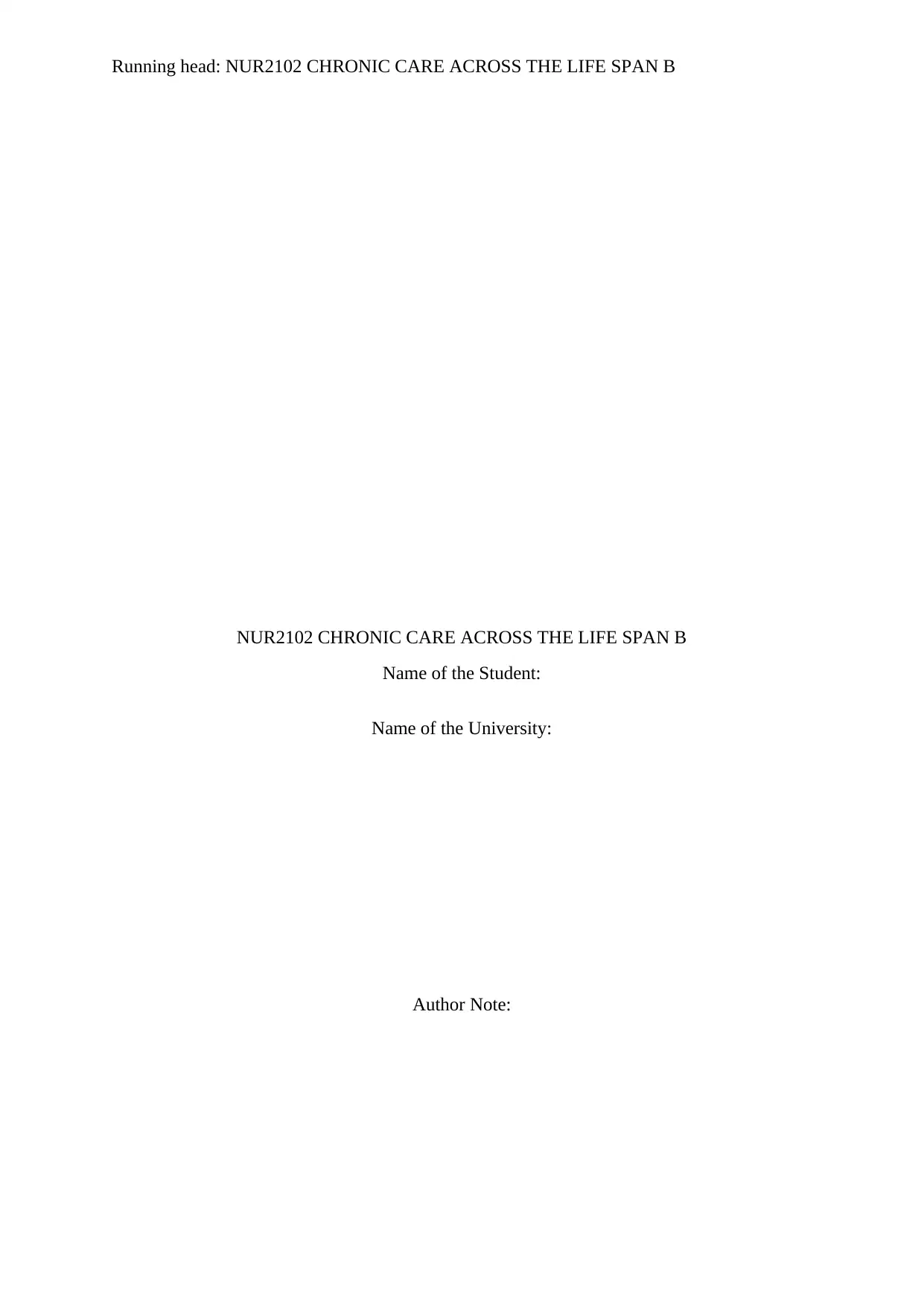
Running head: NUR2102 CHRONIC CARE ACROSS THE LIFE SPAN B
NUR2102 CHRONIC CARE ACROSS THE LIFE SPAN B
Name of the Student:
Name of the University:
Author Note:
NUR2102 CHRONIC CARE ACROSS THE LIFE SPAN B
Name of the Student:
Name of the University:
Author Note:
Paraphrase This Document
Need a fresh take? Get an instant paraphrase of this document with our AI Paraphraser
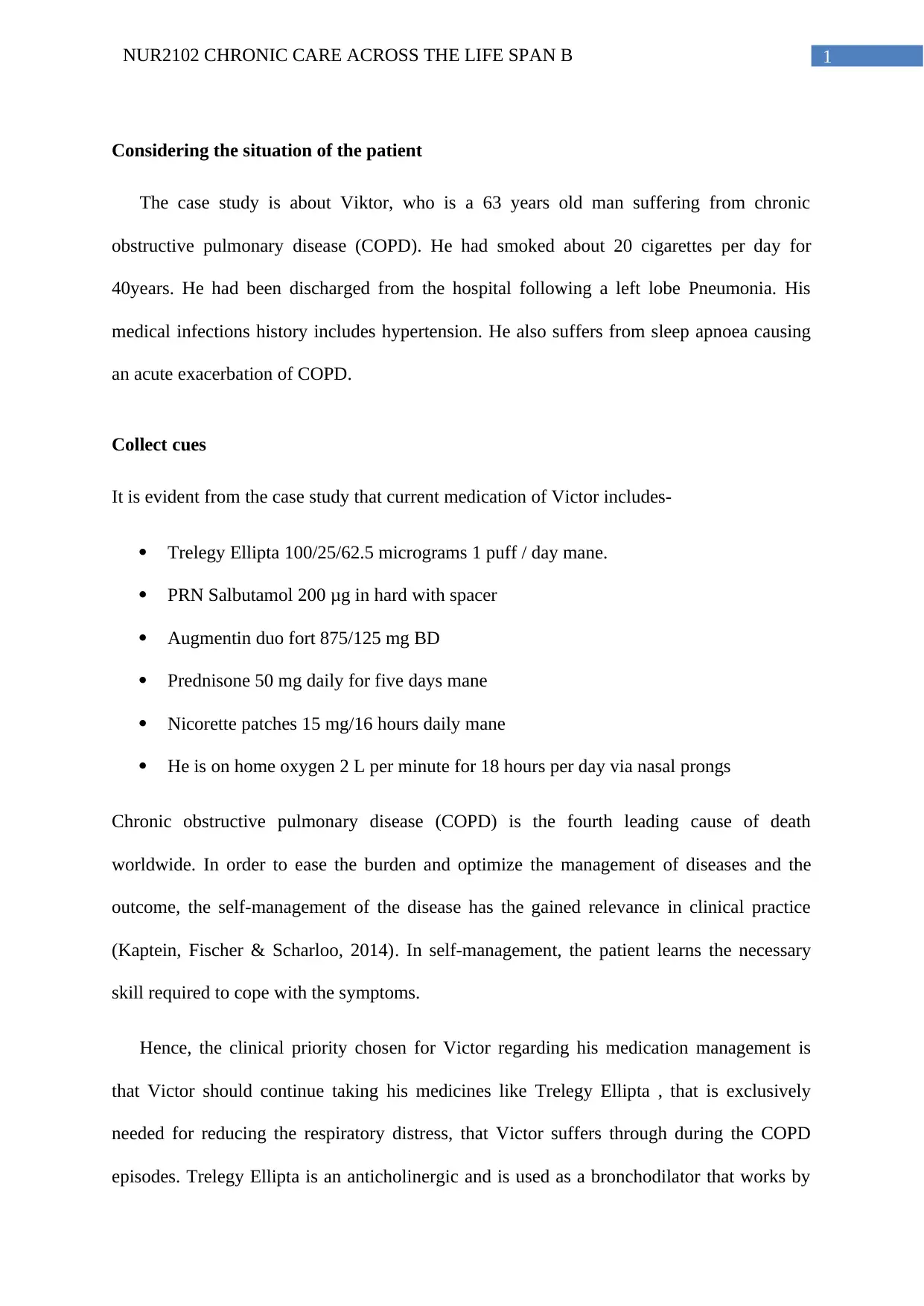
1NUR2102 CHRONIC CARE ACROSS THE LIFE SPAN B
Considering the situation of the patient
The case study is about Viktor, who is a 63 years old man suffering from chronic
obstructive pulmonary disease (COPD). He had smoked about 20 cigarettes per day for
40years. He had been discharged from the hospital following a left lobe Pneumonia. His
medical infections history includes hypertension. He also suffers from sleep apnoea causing
an acute exacerbation of COPD.
Collect cues
It is evident from the case study that current medication of Victor includes-
Trelegy Ellipta 100/25/62.5 micrograms 1 puff / day mane.
PRN Salbutamol 200 μg in hard with spacer
Augmentin duo fort 875/125 mg BD
Prednisone 50 mg daily for five days mane
Nicorette patches 15 mg/16 hours daily mane
He is on home oxygen 2 L per minute for 18 hours per day via nasal prongs
Chronic obstructive pulmonary disease (COPD) is the fourth leading cause of death
worldwide. In order to ease the burden and optimize the management of diseases and the
outcome, the self-management of the disease has the gained relevance in clinical practice
(Kaptein, Fischer & Scharloo, 2014). In self-management, the patient learns the necessary
skill required to cope with the symptoms.
Hence, the clinical priority chosen for Victor regarding his medication management is
that Victor should continue taking his medicines like Trelegy Ellipta , that is exclusively
needed for reducing the respiratory distress, that Victor suffers through during the COPD
episodes. Trelegy Ellipta is an anticholinergic and is used as a bronchodilator that works by
Considering the situation of the patient
The case study is about Viktor, who is a 63 years old man suffering from chronic
obstructive pulmonary disease (COPD). He had smoked about 20 cigarettes per day for
40years. He had been discharged from the hospital following a left lobe Pneumonia. His
medical infections history includes hypertension. He also suffers from sleep apnoea causing
an acute exacerbation of COPD.
Collect cues
It is evident from the case study that current medication of Victor includes-
Trelegy Ellipta 100/25/62.5 micrograms 1 puff / day mane.
PRN Salbutamol 200 μg in hard with spacer
Augmentin duo fort 875/125 mg BD
Prednisone 50 mg daily for five days mane
Nicorette patches 15 mg/16 hours daily mane
He is on home oxygen 2 L per minute for 18 hours per day via nasal prongs
Chronic obstructive pulmonary disease (COPD) is the fourth leading cause of death
worldwide. In order to ease the burden and optimize the management of diseases and the
outcome, the self-management of the disease has the gained relevance in clinical practice
(Kaptein, Fischer & Scharloo, 2014). In self-management, the patient learns the necessary
skill required to cope with the symptoms.
Hence, the clinical priority chosen for Victor regarding his medication management is
that Victor should continue taking his medicines like Trelegy Ellipta , that is exclusively
needed for reducing the respiratory distress, that Victor suffers through during the COPD
episodes. Trelegy Ellipta is an anticholinergic and is used as a bronchodilator that works by
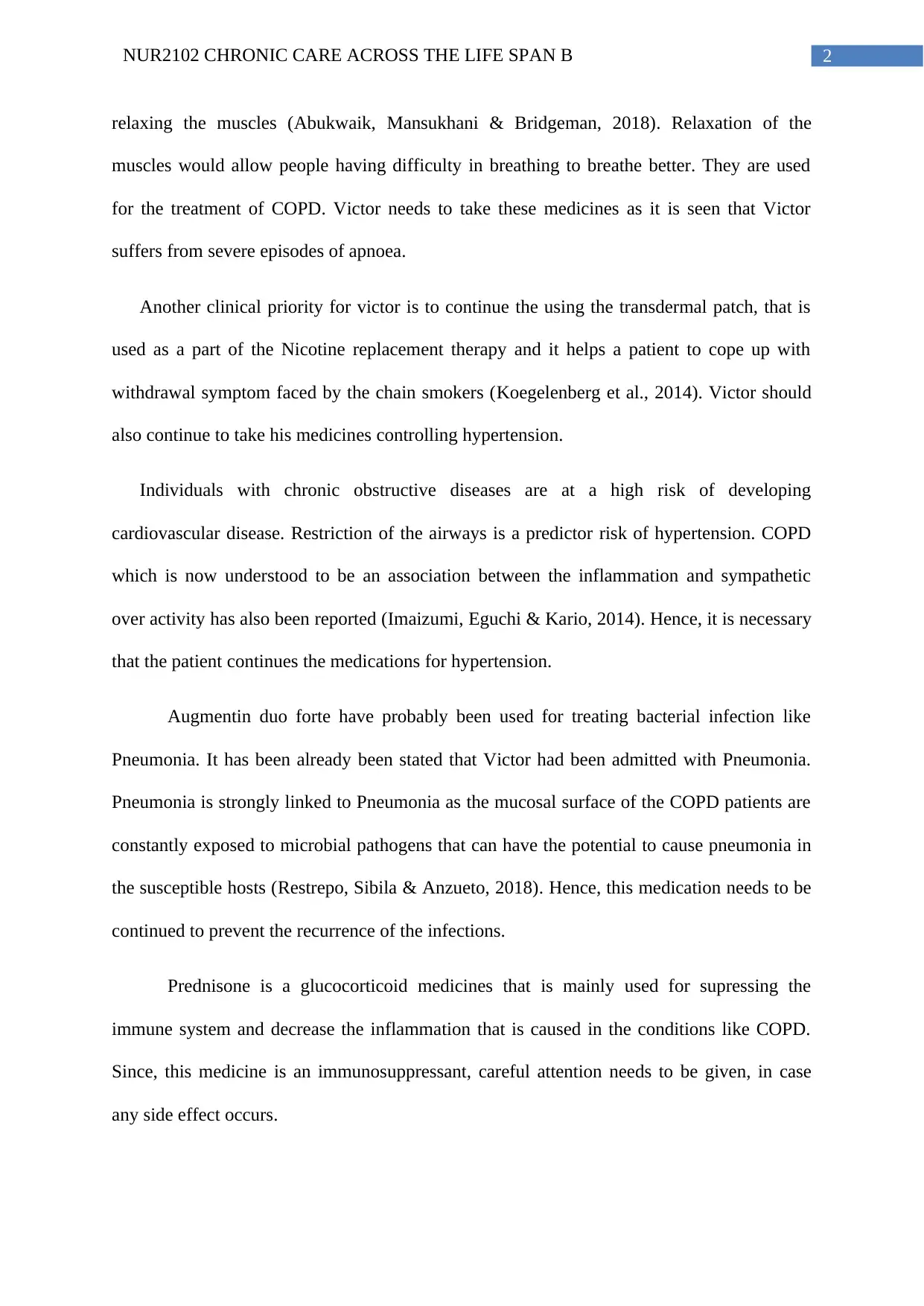
2NUR2102 CHRONIC CARE ACROSS THE LIFE SPAN B
relaxing the muscles (Abukwaik, Mansukhani & Bridgeman, 2018). Relaxation of the
muscles would allow people having difficulty in breathing to breathe better. They are used
for the treatment of COPD. Victor needs to take these medicines as it is seen that Victor
suffers from severe episodes of apnoea.
Another clinical priority for victor is to continue the using the transdermal patch, that is
used as a part of the Nicotine replacement therapy and it helps a patient to cope up with
withdrawal symptom faced by the chain smokers (Koegelenberg et al., 2014). Victor should
also continue to take his medicines controlling hypertension.
Individuals with chronic obstructive diseases are at a high risk of developing
cardiovascular disease. Restriction of the airways is a predictor risk of hypertension. COPD
which is now understood to be an association between the inflammation and sympathetic
over activity has also been reported (Imaizumi, Eguchi & Kario, 2014). Hence, it is necessary
that the patient continues the medications for hypertension.
Augmentin duo forte have probably been used for treating bacterial infection like
Pneumonia. It has been already been stated that Victor had been admitted with Pneumonia.
Pneumonia is strongly linked to Pneumonia as the mucosal surface of the COPD patients are
constantly exposed to microbial pathogens that can have the potential to cause pneumonia in
the susceptible hosts (Restrepo, Sibila & Anzueto, 2018). Hence, this medication needs to be
continued to prevent the recurrence of the infections.
Prednisone is a glucocorticoid medicines that is mainly used for supressing the
immune system and decrease the inflammation that is caused in the conditions like COPD.
Since, this medicine is an immunosuppressant, careful attention needs to be given, in case
any side effect occurs.
relaxing the muscles (Abukwaik, Mansukhani & Bridgeman, 2018). Relaxation of the
muscles would allow people having difficulty in breathing to breathe better. They are used
for the treatment of COPD. Victor needs to take these medicines as it is seen that Victor
suffers from severe episodes of apnoea.
Another clinical priority for victor is to continue the using the transdermal patch, that is
used as a part of the Nicotine replacement therapy and it helps a patient to cope up with
withdrawal symptom faced by the chain smokers (Koegelenberg et al., 2014). Victor should
also continue to take his medicines controlling hypertension.
Individuals with chronic obstructive diseases are at a high risk of developing
cardiovascular disease. Restriction of the airways is a predictor risk of hypertension. COPD
which is now understood to be an association between the inflammation and sympathetic
over activity has also been reported (Imaizumi, Eguchi & Kario, 2014). Hence, it is necessary
that the patient continues the medications for hypertension.
Augmentin duo forte have probably been used for treating bacterial infection like
Pneumonia. It has been already been stated that Victor had been admitted with Pneumonia.
Pneumonia is strongly linked to Pneumonia as the mucosal surface of the COPD patients are
constantly exposed to microbial pathogens that can have the potential to cause pneumonia in
the susceptible hosts (Restrepo, Sibila & Anzueto, 2018). Hence, this medication needs to be
continued to prevent the recurrence of the infections.
Prednisone is a glucocorticoid medicines that is mainly used for supressing the
immune system and decrease the inflammation that is caused in the conditions like COPD.
Since, this medicine is an immunosuppressant, careful attention needs to be given, in case
any side effect occurs.
⊘ This is a preview!⊘
Do you want full access?
Subscribe today to unlock all pages.

Trusted by 1+ million students worldwide
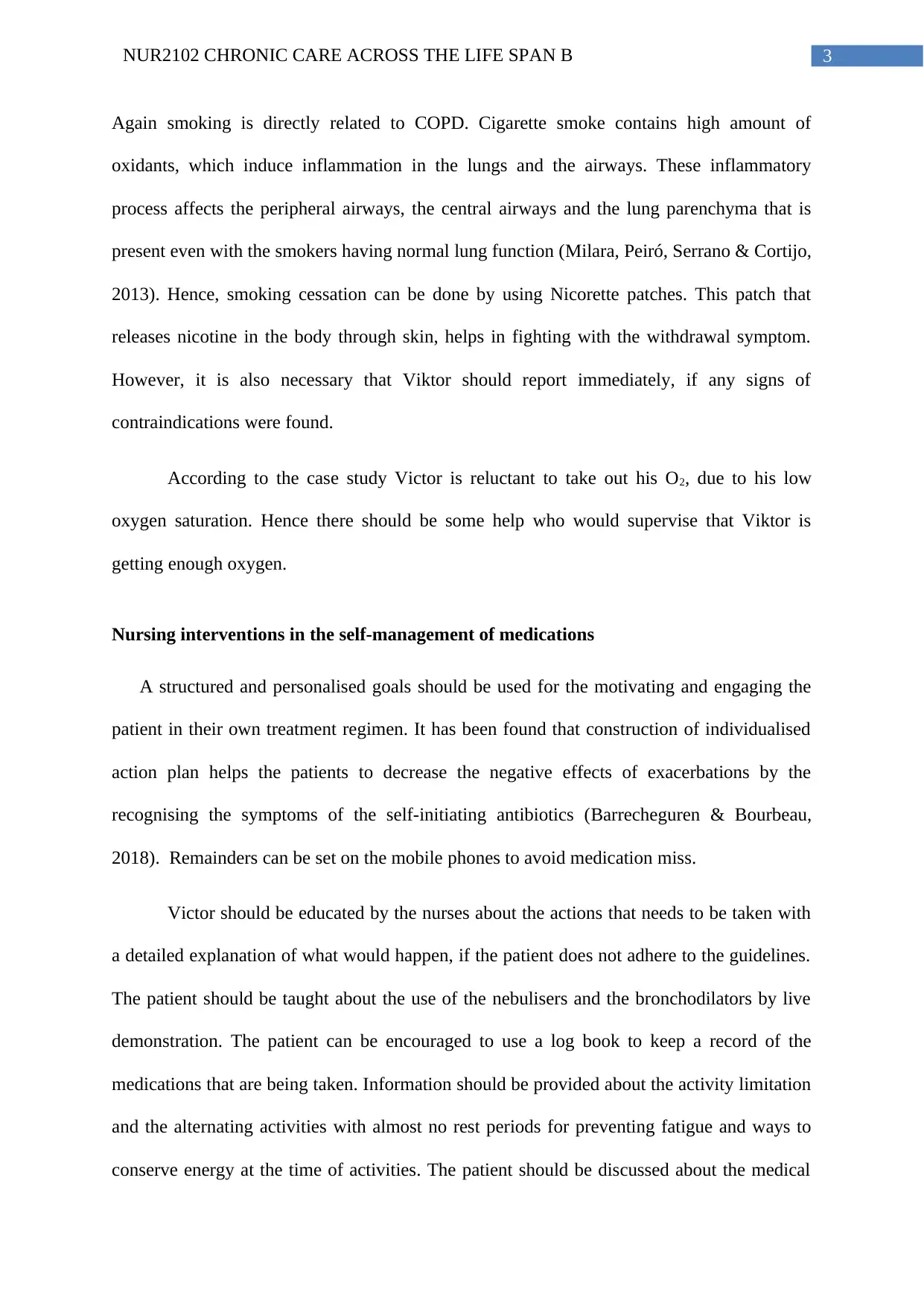
3NUR2102 CHRONIC CARE ACROSS THE LIFE SPAN B
Again smoking is directly related to COPD. Cigarette smoke contains high amount of
oxidants, which induce inflammation in the lungs and the airways. These inflammatory
process affects the peripheral airways, the central airways and the lung parenchyma that is
present even with the smokers having normal lung function (Milara, Peiró, Serrano & Cortijo,
2013). Hence, smoking cessation can be done by using Nicorette patches. This patch that
releases nicotine in the body through skin, helps in fighting with the withdrawal symptom.
However, it is also necessary that Viktor should report immediately, if any signs of
contraindications were found.
According to the case study Victor is reluctant to take out his O2, due to his low
oxygen saturation. Hence there should be some help who would supervise that Viktor is
getting enough oxygen.
Nursing interventions in the self-management of medications
A structured and personalised goals should be used for the motivating and engaging the
patient in their own treatment regimen. It has been found that construction of individualised
action plan helps the patients to decrease the negative effects of exacerbations by the
recognising the symptoms of the self-initiating antibiotics (Barrecheguren & Bourbeau,
2018). Remainders can be set on the mobile phones to avoid medication miss.
Victor should be educated by the nurses about the actions that needs to be taken with
a detailed explanation of what would happen, if the patient does not adhere to the guidelines.
The patient should be taught about the use of the nebulisers and the bronchodilators by live
demonstration. The patient can be encouraged to use a log book to keep a record of the
medications that are being taken. Information should be provided about the activity limitation
and the alternating activities with almost no rest periods for preventing fatigue and ways to
conserve energy at the time of activities. The patient should be discussed about the medical
Again smoking is directly related to COPD. Cigarette smoke contains high amount of
oxidants, which induce inflammation in the lungs and the airways. These inflammatory
process affects the peripheral airways, the central airways and the lung parenchyma that is
present even with the smokers having normal lung function (Milara, Peiró, Serrano & Cortijo,
2013). Hence, smoking cessation can be done by using Nicorette patches. This patch that
releases nicotine in the body through skin, helps in fighting with the withdrawal symptom.
However, it is also necessary that Viktor should report immediately, if any signs of
contraindications were found.
According to the case study Victor is reluctant to take out his O2, due to his low
oxygen saturation. Hence there should be some help who would supervise that Viktor is
getting enough oxygen.
Nursing interventions in the self-management of medications
A structured and personalised goals should be used for the motivating and engaging the
patient in their own treatment regimen. It has been found that construction of individualised
action plan helps the patients to decrease the negative effects of exacerbations by the
recognising the symptoms of the self-initiating antibiotics (Barrecheguren & Bourbeau,
2018). Remainders can be set on the mobile phones to avoid medication miss.
Victor should be educated by the nurses about the actions that needs to be taken with
a detailed explanation of what would happen, if the patient does not adhere to the guidelines.
The patient should be taught about the use of the nebulisers and the bronchodilators by live
demonstration. The patient can be encouraged to use a log book to keep a record of the
medications that are being taken. Information should be provided about the activity limitation
and the alternating activities with almost no rest periods for preventing fatigue and ways to
conserve energy at the time of activities. The patient should be discussed about the medical
Paraphrase This Document
Need a fresh take? Get an instant paraphrase of this document with our AI Paraphraser
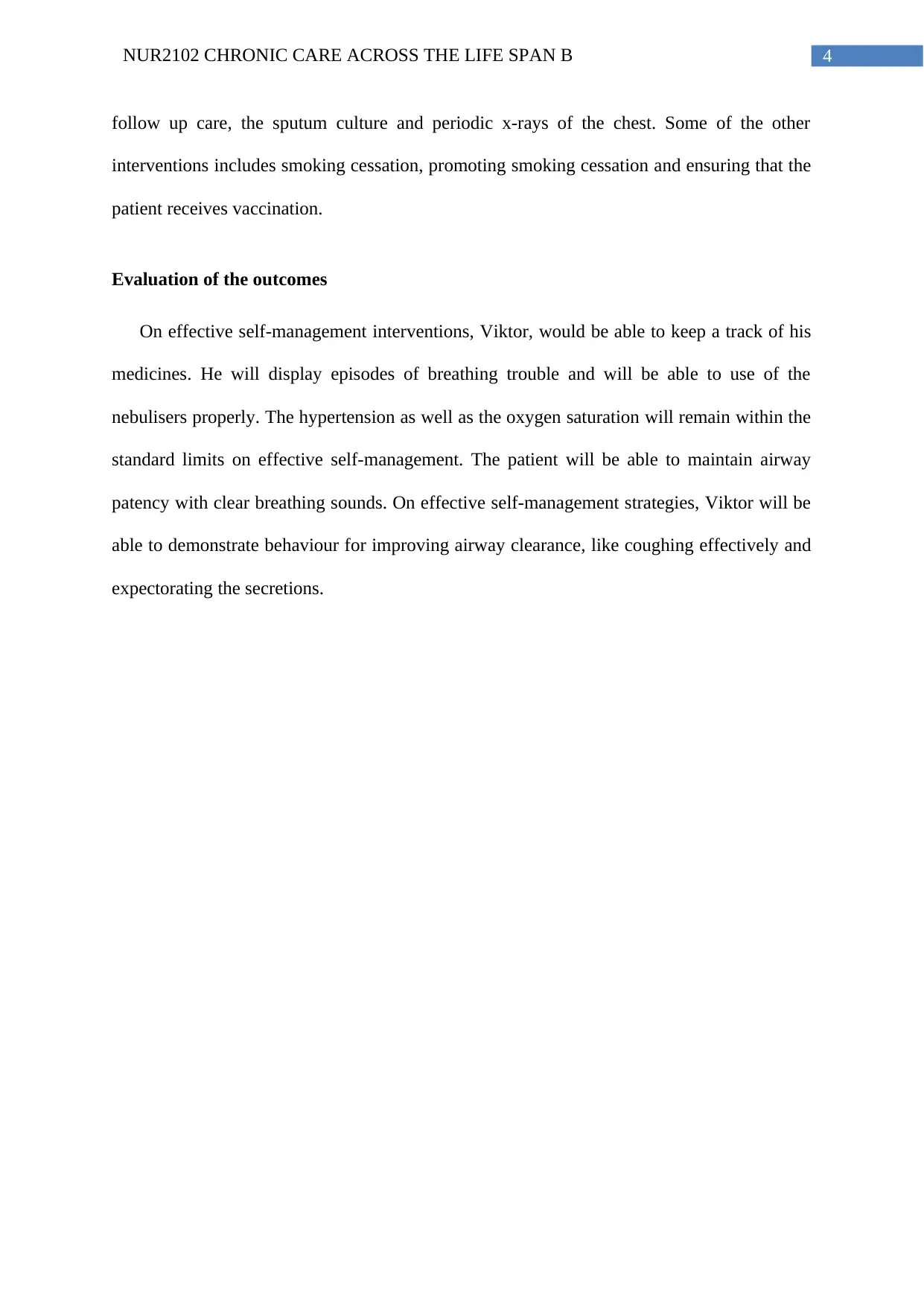
4NUR2102 CHRONIC CARE ACROSS THE LIFE SPAN B
follow up care, the sputum culture and periodic x-rays of the chest. Some of the other
interventions includes smoking cessation, promoting smoking cessation and ensuring that the
patient receives vaccination.
Evaluation of the outcomes
On effective self-management interventions, Viktor, would be able to keep a track of his
medicines. He will display episodes of breathing trouble and will be able to use of the
nebulisers properly. The hypertension as well as the oxygen saturation will remain within the
standard limits on effective self-management. The patient will be able to maintain airway
patency with clear breathing sounds. On effective self-management strategies, Viktor will be
able to demonstrate behaviour for improving airway clearance, like coughing effectively and
expectorating the secretions.
follow up care, the sputum culture and periodic x-rays of the chest. Some of the other
interventions includes smoking cessation, promoting smoking cessation and ensuring that the
patient receives vaccination.
Evaluation of the outcomes
On effective self-management interventions, Viktor, would be able to keep a track of his
medicines. He will display episodes of breathing trouble and will be able to use of the
nebulisers properly. The hypertension as well as the oxygen saturation will remain within the
standard limits on effective self-management. The patient will be able to maintain airway
patency with clear breathing sounds. On effective self-management strategies, Viktor will be
able to demonstrate behaviour for improving airway clearance, like coughing effectively and
expectorating the secretions.
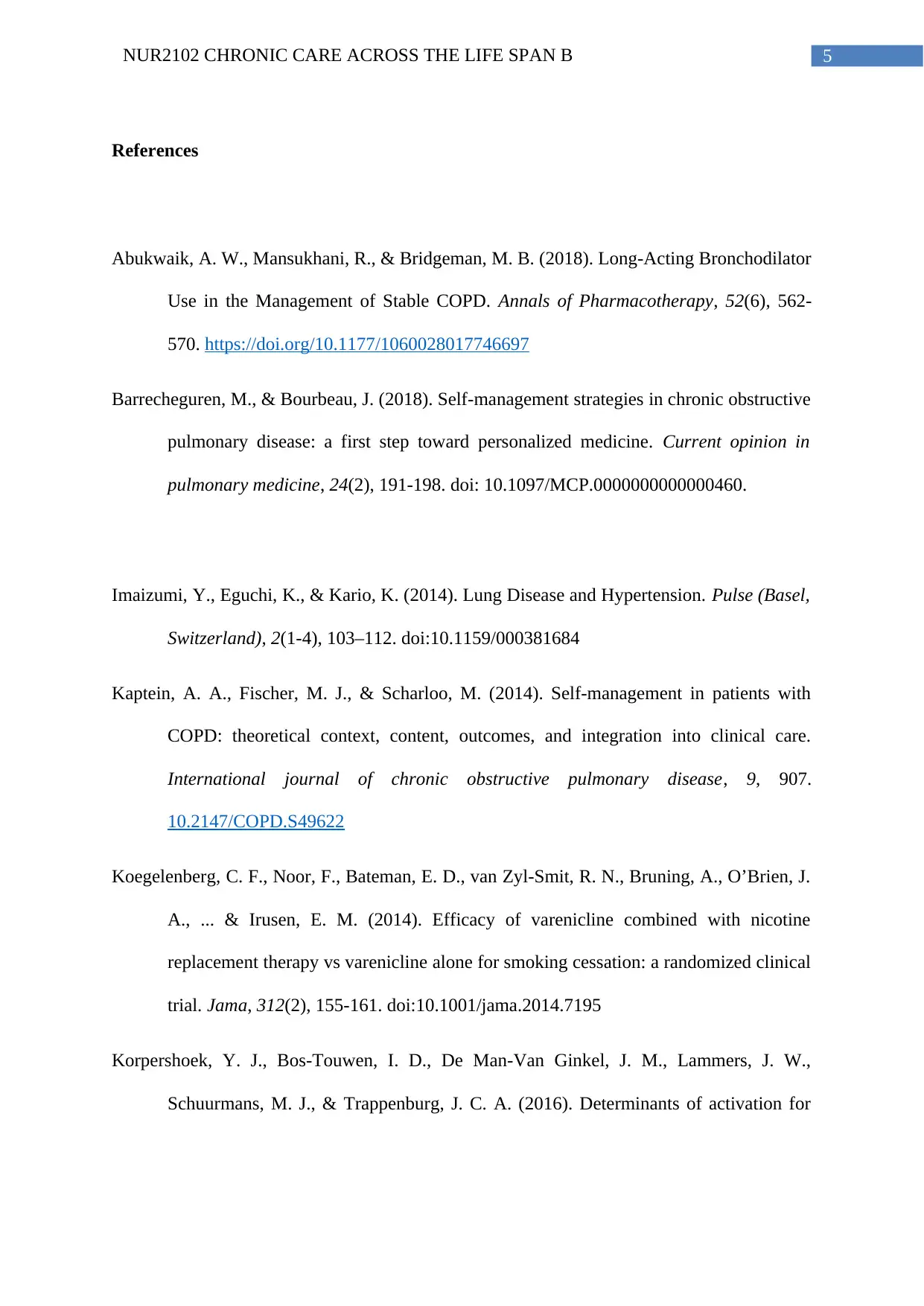
5NUR2102 CHRONIC CARE ACROSS THE LIFE SPAN B
References
Abukwaik, A. W., Mansukhani, R., & Bridgeman, M. B. (2018). Long-Acting Bronchodilator
Use in the Management of Stable COPD. Annals of Pharmacotherapy, 52(6), 562-
570. https://doi.org/10.1177/1060028017746697
Barrecheguren, M., & Bourbeau, J. (2018). Self-management strategies in chronic obstructive
pulmonary disease: a first step toward personalized medicine. Current opinion in
pulmonary medicine, 24(2), 191-198. doi: 10.1097/MCP.0000000000000460.
Imaizumi, Y., Eguchi, K., & Kario, K. (2014). Lung Disease and Hypertension. Pulse (Basel,
Switzerland), 2(1-4), 103–112. doi:10.1159/000381684
Kaptein, A. A., Fischer, M. J., & Scharloo, M. (2014). Self-management in patients with
COPD: theoretical context, content, outcomes, and integration into clinical care.
International journal of chronic obstructive pulmonary disease, 9, 907.
10.2147/COPD.S49622
Koegelenberg, C. F., Noor, F., Bateman, E. D., van Zyl-Smit, R. N., Bruning, A., O’Brien, J.
A., ... & Irusen, E. M. (2014). Efficacy of varenicline combined with nicotine
replacement therapy vs varenicline alone for smoking cessation: a randomized clinical
trial. Jama, 312(2), 155-161. doi:10.1001/jama.2014.7195
Korpershoek, Y. J., Bos-Touwen, I. D., De Man-Van Ginkel, J. M., Lammers, J. W.,
Schuurmans, M. J., & Trappenburg, J. C. A. (2016). Determinants of activation for
References
Abukwaik, A. W., Mansukhani, R., & Bridgeman, M. B. (2018). Long-Acting Bronchodilator
Use in the Management of Stable COPD. Annals of Pharmacotherapy, 52(6), 562-
570. https://doi.org/10.1177/1060028017746697
Barrecheguren, M., & Bourbeau, J. (2018). Self-management strategies in chronic obstructive
pulmonary disease: a first step toward personalized medicine. Current opinion in
pulmonary medicine, 24(2), 191-198. doi: 10.1097/MCP.0000000000000460.
Imaizumi, Y., Eguchi, K., & Kario, K. (2014). Lung Disease and Hypertension. Pulse (Basel,
Switzerland), 2(1-4), 103–112. doi:10.1159/000381684
Kaptein, A. A., Fischer, M. J., & Scharloo, M. (2014). Self-management in patients with
COPD: theoretical context, content, outcomes, and integration into clinical care.
International journal of chronic obstructive pulmonary disease, 9, 907.
10.2147/COPD.S49622
Koegelenberg, C. F., Noor, F., Bateman, E. D., van Zyl-Smit, R. N., Bruning, A., O’Brien, J.
A., ... & Irusen, E. M. (2014). Efficacy of varenicline combined with nicotine
replacement therapy vs varenicline alone for smoking cessation: a randomized clinical
trial. Jama, 312(2), 155-161. doi:10.1001/jama.2014.7195
Korpershoek, Y. J., Bos-Touwen, I. D., De Man-Van Ginkel, J. M., Lammers, J. W.,
Schuurmans, M. J., & Trappenburg, J. C. A. (2016). Determinants of activation for
⊘ This is a preview!⊘
Do you want full access?
Subscribe today to unlock all pages.

Trusted by 1+ million students worldwide
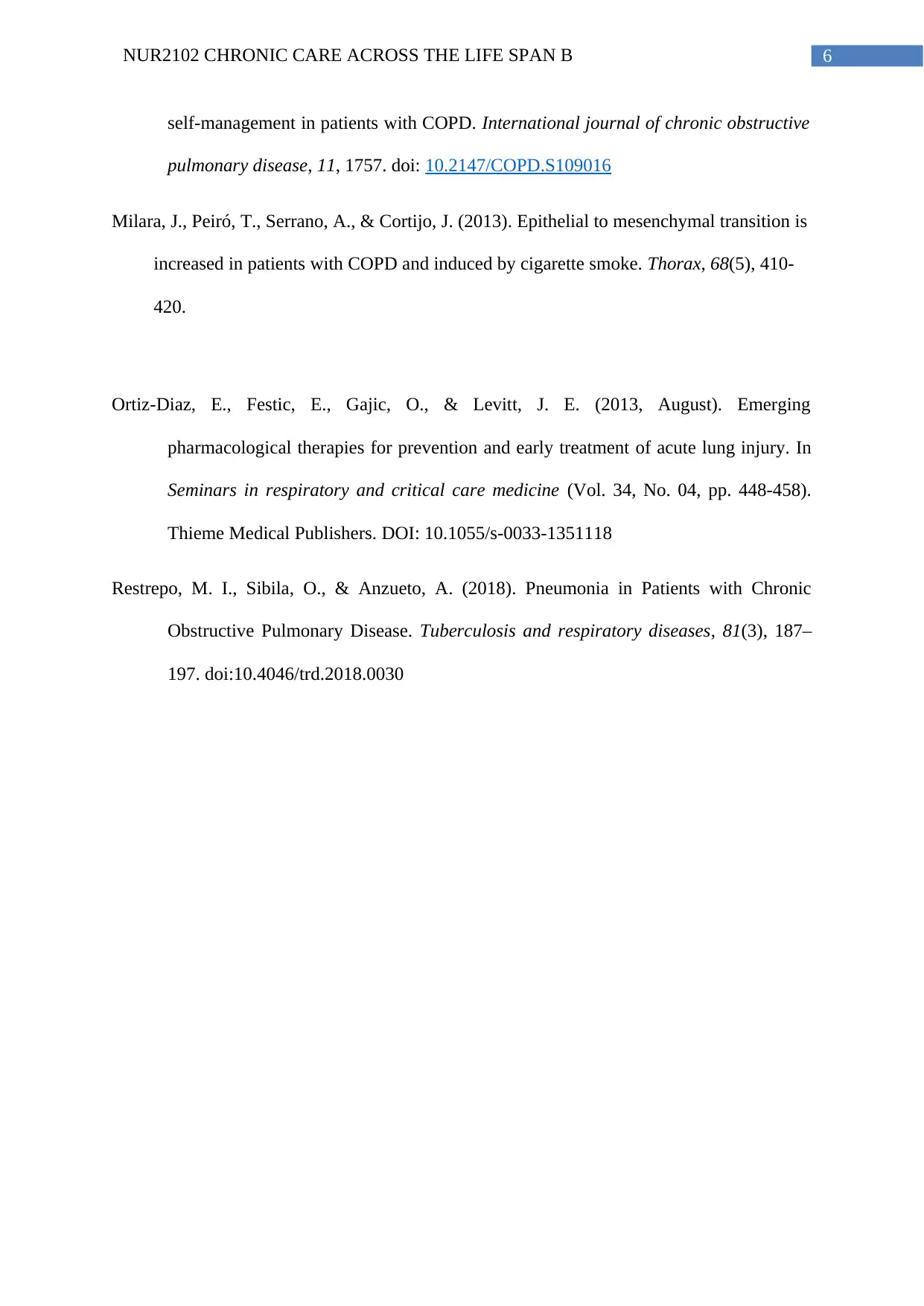
6NUR2102 CHRONIC CARE ACROSS THE LIFE SPAN B
self-management in patients with COPD. International journal of chronic obstructive
pulmonary disease, 11, 1757. doi: 10.2147/COPD.S109016
Milara, J., Peiró, T., Serrano, A., & Cortijo, J. (2013). Epithelial to mesenchymal transition is
increased in patients with COPD and induced by cigarette smoke. Thorax, 68(5), 410-
420.
Ortiz-Diaz, E., Festic, E., Gajic, O., & Levitt, J. E. (2013, August). Emerging
pharmacological therapies for prevention and early treatment of acute lung injury. In
Seminars in respiratory and critical care medicine (Vol. 34, No. 04, pp. 448-458).
Thieme Medical Publishers. DOI: 10.1055/s-0033-1351118
Restrepo, M. I., Sibila, O., & Anzueto, A. (2018). Pneumonia in Patients with Chronic
Obstructive Pulmonary Disease. Tuberculosis and respiratory diseases, 81(3), 187–
197. doi:10.4046/trd.2018.0030
self-management in patients with COPD. International journal of chronic obstructive
pulmonary disease, 11, 1757. doi: 10.2147/COPD.S109016
Milara, J., Peiró, T., Serrano, A., & Cortijo, J. (2013). Epithelial to mesenchymal transition is
increased in patients with COPD and induced by cigarette smoke. Thorax, 68(5), 410-
420.
Ortiz-Diaz, E., Festic, E., Gajic, O., & Levitt, J. E. (2013, August). Emerging
pharmacological therapies for prevention and early treatment of acute lung injury. In
Seminars in respiratory and critical care medicine (Vol. 34, No. 04, pp. 448-458).
Thieme Medical Publishers. DOI: 10.1055/s-0033-1351118
Restrepo, M. I., Sibila, O., & Anzueto, A. (2018). Pneumonia in Patients with Chronic
Obstructive Pulmonary Disease. Tuberculosis and respiratory diseases, 81(3), 187–
197. doi:10.4046/trd.2018.0030
1 out of 7
Related Documents
Your All-in-One AI-Powered Toolkit for Academic Success.
+13062052269
info@desklib.com
Available 24*7 on WhatsApp / Email
![[object Object]](/_next/static/media/star-bottom.7253800d.svg)
Unlock your academic potential
Copyright © 2020–2025 A2Z Services. All Rights Reserved. Developed and managed by ZUCOL.





